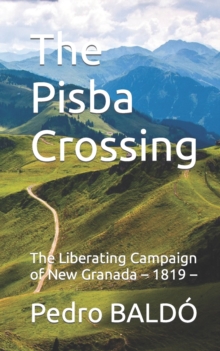This is the story of Bolivar's small army epic climb across the Andes, through Paramo de Pisba, half the size of the opposition's round Bogota, having slithered and swum across the inundated Casanare plains, who arriving at the foot of the eastern cordillera of the Andes in Tame, scattered a royalist outpost.
In Tame, there were three possible routes that Bolivar could take within the valley of Sogamoso: the Salina de Chita, the Labranzagrande or the Pisba Andes Pass. The first two were easily accessible, but they were heavily patrolled by enemy troops, the third was free from enemy surveillance, but its transit was very complicated due to the broken-field characteristics, and the height the troops were meant to escalate. Bolivar decided on the latter due to the fact it would be the least expected by the enemy.
The historic climb which then commenced is best described in the words of Daniel Florencio O'Leary, General Daniel Florencio O'LEARY BURKE of Cork, Chief A.D.C. to Bolivar:
The crossing of the Plains of the Casanare - a sea of water - and the climbing of the steep and slippery slopes of the Andes, were by comparison, absolutely nothing compared to the journey that now lay in front of the army. In many places the path was blocked by huge boulders, and fallen trees; avalanches, brought down by the interminable rain, had made it slippery and treacherous underfoot. The soldiers, who had received a four-day meat ration, threw it away, regarding their rifles as quite enough weight to have to carry on this terrible climb.
Late at night, on July 2nd, the army camped at the foot of the Paramo - and what a night that was !! Not a single shelter of any kind in sight, and the icy wind and the incessant rain, blowing across the open ground extinguished the camp fires the moment they were lit. As the troops were half naked, and the majority of them natives were of the boiling plains of Venezuela their intolerable sufferings may more easily be imagined than described.
On the following day the Paramo itself hovered into view - a gloomy, inhospitable desert devoid of vegetation owing to its great height (13,500 ft). During the march that day the cold, penetrating air proved fatal to many of the soldiers, who turned suddenly ill and died within minutes. The lash was used successfully in several cases, including that something nearby. I asked them what they were doing and they replied that a rifleman's wife was in birth pains. The next day I saw the same woman, apparently in the best of health marching along in the vanguard, her baby in her arms. Since giving birth she had covered no less than two leagues over one of the worst tracks in the terrible country.
This amazing ordeal , against all odds for success, leads to the final victory at Boyaca on 08.07.1819 and the Liberation of New Granada.
https://www.geni.com/projects/Bicentennial-Campa%C3%B1a-Libertadora-de-la-Nueva-Granada-1819-2019/55115
https://www.geni.com/projects/Bicentennial-of-Pe%C3%B1a-de-T%C3%B3paga-Combat-and-Vargas-Swamp-Battle-1819-2019/55861
https://www.geni.com/projects/British-Legions-South-American-Wars-Portal/54226
https://www.geni.com/projects/Bicentennial-of-the-Battle-of-Boyac%C3%A1-1819-2019/56158

